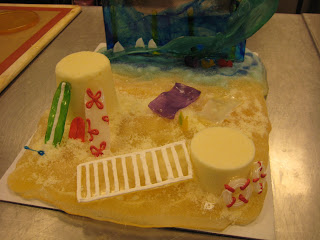It took a day of deep-frying at a French school to awaken my latent fried-foods heritage and understand where my dad was coming from. And it was actually an Italian dessert that really did me in. Behold, the magnificent bomboloni!



I've actually mentioned bomboloni on this blog before. And those were good. But these were even better. I feel confident an equation could be written to demonstrate that the deliciousness of fried things is inversely proportional to the amount of time they've been out of the fryer. And these were as freshly fried as they could be.
Great frying is both a science and an art. On the science side, there are strict rules about temperature and time that must be obeyed. The best deep frying occurs when the oil is between 350 and 400 F. Cold oil won't cook things quickly enough and results in a soggy, greasy final product, while oil hotter than 425 F becomes toxic. Also important: never mix old and new oil, never pour cooking oil down the drain, and NEVER throw water on a grease fire. Our chef showed us a short, but effectively horrifying, video about the dangers of that last. I like my eyebrows and my face, so I'm all about safety when deep-frying.
Thus armed with important safety knowledge, we set about making our bomboloni. Even rounds of brioche dough, rolled smooth and left to proof on our workbench, were scooped up and (gently, to prevent potentially scarring hot oil spatters) deposited in the waiting oil. A soft plop, a quick hissing sizzle, and the brioche rounds bobbed merrily in our cast iron pan. After a few minutes, we nudged them to flip and reveal a golden underbelly. A few minutes more, and they were scooped from the hot oil, rolled in granulated sugar, and filled with pastry cream or raspberry jam. Plated desserts are all about presentation, so we carefully arranged a trio of bomboloni with the three corresponding sauces. A small scoop of ice cream and a crunchy tuile cookie added contrast in texture and temperature. The overall effect was knock-your-socks-off delicious. With a still-hot, crispy sugared exterior and rich, tender interior giving way to a creamy vanilla or chocolate filling, these Italian doughnuts have Dunkin' beat by a mile.
To round out our deep-frying education, we made tropical beignets and deep-fried crepes. Making the batter was fun: how many times have you gotten to crack open a bottle of beer at 9 am in the name of education? The batter was the most complicated part of the recipe, as it remained only to dip chunks of tropical fruit in the batter and send them the way of the bomboloni.

Pretty as the starfruit and mango looked, I didn't really like the way they tasted deep-fried. The tart flavors and firm texture were an odd juxtaposition with the bread-like batter. Banana beignets, however, I can recommend without reservation. They taste a little bit like my favorite banana pancakes, but more caramelized and yeasty. And they can be put on a stick, which any fan of State Fair cuisine knows is a real plus.
Our final deep-frying adventure was apple-filled crepes. They weren't bad, but the best thing about them was the hard cider ice cream we served alongside. Of course, by that point in the afternoon I smelled like I had been soaked in frying oil and was starting to feel slightly ill. Delicious as it is, I may not have inherited my Southern antecedents' tolerance for massive amounts of deep-fried food. For this Minnesota girl, deep-frying may be an adventure best reserved for special occasions. I'm thinking Thanksgiving, I'm thinking turkey...








